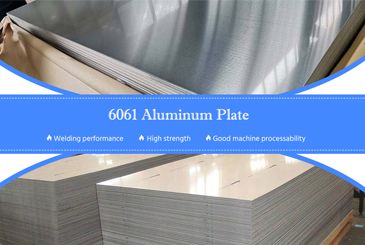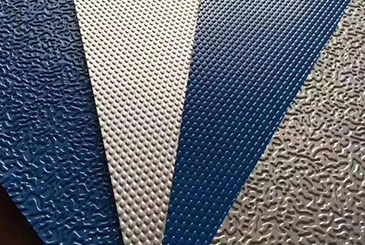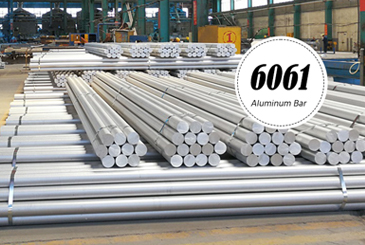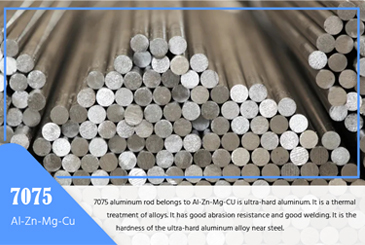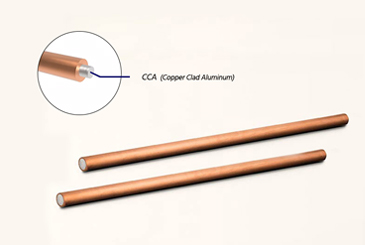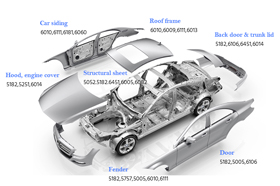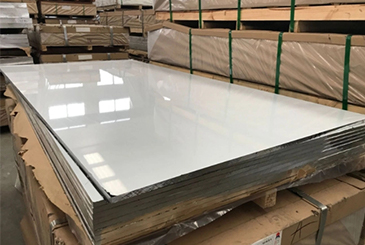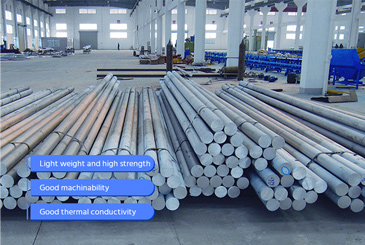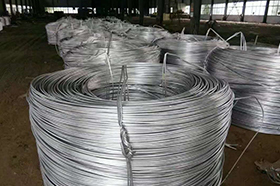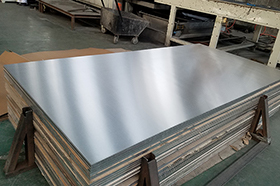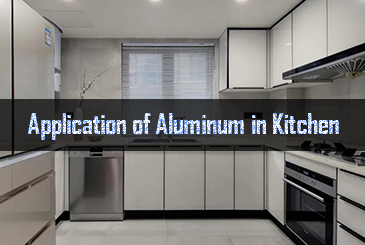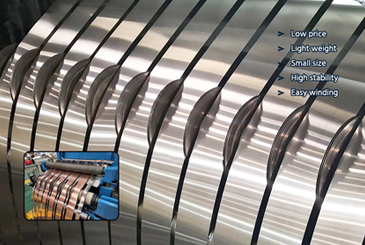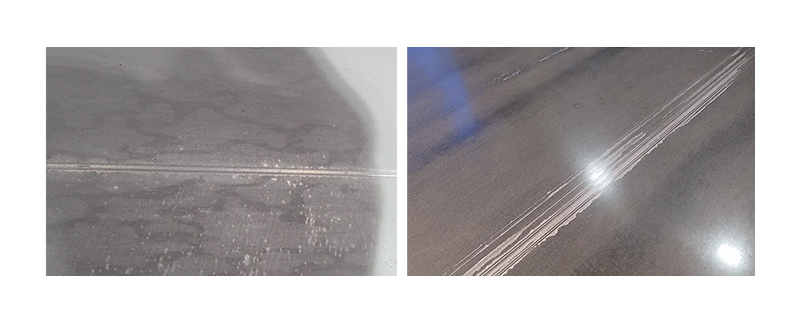A burnt child dreads the fire. When you purchase defective aluminum plates, it can be quite frustrating. Not only can it impact your business and production processes, but it also leads to wasted time and resources.Quick Quote
Defects in aluminum plates typically manifest in issues related to dimensional accuracy, shape, surface quality, and performance, among others. In this article, Chalco will guide you on how to identify these defects and provide solutions for improvement.
Classification of aluminum plate defects
Defects severely affecting usability
- Penetrating porosity, inclusions, and overburn that result in non-compact microstructure and weaken grain-to-grain bonding.
- Corrosion, diffusion, white spots, delamination of aluminum layers, nitrate traces, and slip lines that compromise product corrosion resistance.
- Edge cracks, fissures, and shrinkage holes that undermine the overall product structure.
- Mechanical properties and dimensional accuracy that do not meet usage or standard requirements.Quick Quote
Minor defects with slight impact on usability
- Surface bubbles, ripples, scratches, emulsion marks, dents, pressure marks, imprints, adhesive marks, transverse waves, and peeling.
- Folding, non-metallic inclusions, metal inclusions, and loose dendritic patterns.
- Small black spots and abrasions.Quick Quote
Other defects
Defects that are not explicitly specified or are very nonspecific fall into this category:
Bowing, oil marks, water stains, surface dullness, and patterns.
Analysis of dimensional accuracy defects in aluminum plates
Too thin
The aluminum plate thickness is less than the minimum allowed by the standard, directly impacting usability.
Irregular thickness reduction adjustment. significant errors in thickness reduction indicators. improper micrometer adjustment. incorrect roll control.
Too thick
The aluminum plate thickness exceeds the maximum allowed by the standard, directly affecting usability.
Irregular thickness reduction adjustment. significant errors in thickness reduction indicators. improper micrometer adjustment. incorrect roll control.
Too narrow
The aluminum plate width is less than the minimum allowed by the standard, affecting usability.Quick Quote
Inadequate consideration of cold contraction during hot press round disc shear adjustment. incorrect measurements during saw cutting.
Too short
The aluminum plate length is less than the minimum allowed by the standard, affecting usability.
Poor length control during hot rolling shear. inadequate consideration of cold shrinkage during fixed-length shearing on thick plate machines. measurement errors during saw cutting.
Inconsistent aluminum cladding
The aluminum cladding layer thickness does not meet the standard requirements, directly affecting corrosion resistance and welding performance.
Excessive reduction during hot rolling welding and calendering. incorrect aluminum cladding thickness.
Aluminum plate shape defect analysis
Unevenness
Aluminum plate is not flat and exhibits an uneven or wavy surface. Typically, this occurs in the rolling direction and is determined by wave height, wave spacing, and the number of waves. It directly impacts usability.
Uneven stretching of the plate in the transverse direction during rolling. if there is uneven temperature distribution in the transverse direction during subsequent processes, it can lead to distortion and also affect flatness.Quick Quote
Edge waves
Edge waviness in aluminum plates refers to the overall unevenness or waviness along the plate's edges. The plate's edges repeatedly exhibit waves, affecting usability.
During rolling, the edges stretch more than the central part.
Adjusting the initial roller crown, enhancing cooling, and increasing roller deflection can improve edge waves.
Center waves
Central waviness in aluminum plates refers to the unevenness or degree of waviness in the central portion of the plate. The central area of the aluminum plate repeatedly exhibits waves, affecting usability.
During rolling, the central part stretches more than the edges.
Modifying roller crown, intensifying cooling, and reducing roller deflection can alter the central waves.
1/4 position waves (ribbed waves)
The degree of unevenness or waviness near the edge of the aluminum plate, approximately 1/4 of the plate width in the transverse direction, affects usability.
The combination of roller deformation caused by rolling and inappropriate roller crown, resulting in an increased stretch from the transverse edge to the central part.
Effective combination of roller initial crown and control of cooling levels in different roller zones can lead to improvement.
Composite waves
Waves occurring simultaneously at the edges and in the middle. Repeated waves at both the edges and in the middle, affecting usability.
Excessive roller initial crown, increased thermal crown, resulting in rapid waves in the middle. When attempting to reduce roller bending to address this issue, edge waves can easily occur.
Measures such as strengthening cooling in the middle of the rollers and adjusting the roller bending force can be taken to prevent this issue.Quick Quote
Localized depressions or one-sided waves
Undulations appearing at specific positions transversely on the aluminum plate. These undulations repeatedly occur at specific transverse positions with small wave intervals, affecting usability.
Partial blockage in the lubrication pipe, resulting in localized heating and bulging of the roller, which eventually develops into a localized depression.
Adjust the lubrication system to lubricate as per the requirements.
Side bending
Uneven deformation during rolling, causing the aluminum plate to bend to one side in the horizontal plane, affecting usability.
The incorrect roller profile. misalignment of the aluminum plate during rolling. clogged emulsion nozzles, leading to uneven roller cooling. variation in thickness on both sides of the incoming plate. uneven deformation on both sides during rolling or pressing.
Localized waves
Short-period undulations that appear on the aluminum plate during rolling. These are short-cycle peaks and troughs at any position and in any direction on the aluminum plate within a range of 500mm. If they exceed the specified standards, the plate cannot be used.
Uneven lubrication and cooling. improper roller profile control.
Longitudinal bending
When an aluminum plate is placed on a flat surface, it exhibits an upward curling of its front and rear edges, or this refers to the degree of curling at this moment. If it exceeds the specified standards, the plate cannot be used.
Inappropriate straightening conditions and processes. uneven distribution of thickness deformation in the aluminum plate. imbalanced and uneven distribution of internal stress.
Transverse bending
When an aluminum plate is placed on a flat surface, it exhibits an upward curling of its transverse edges, or this refers to the degree of curling at this moment. If it exceeds the specified standards, the plate cannot be used.
The aluminum plate exhibits uneven transverse thickness deformation, asymmetry, and an imbalance in internal stress.Quick Quote
Surface defect analysis of aluminum plates
Surface bubbles
Irregular strip or circular cavities or protrusions on the surface of the aluminum plate, characterized by smooth edges and asymmetry in the vertical direction. They can impact the material's mechanical properties and corrosion resistance.
The ingot has a high gas content, a porous structure, and should undergo improved molten metal purification. There is dirt on the uneven surface of the casting block, which was not cleaned before loading into the furnace. There are corroded residues between the casting block and the clad aluminum plate.
Excessive heating temperature or prolonged heating time of the casting block leads to surface oxidation. During welding and rolling, emulsion flows beneath the clad aluminum plate.Quick Quote
Attention should be paid to environmental control, refining and purification treatment, and the thickness of the ingot milling surface.
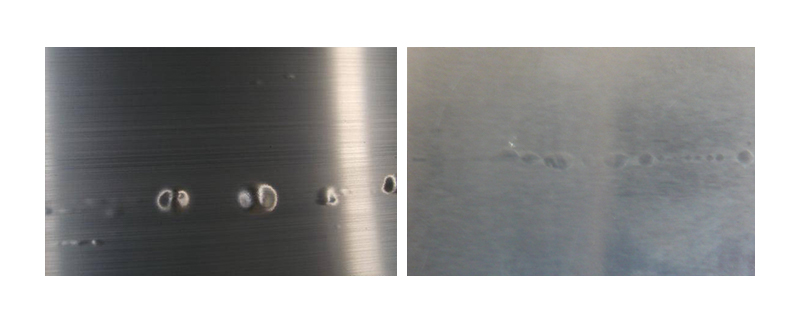
Through-hole porosity
Bubbles penetrating through the thickness of the aluminum plate, symmetrically in the vertical direction, appearing as circular or strip-shaped protrusions. They disrupt the compactness of the structure and reduce mechanical properties, rendering the plate as absolute scrap.
Concentrated bubbles within the ingot that remain on the aluminum plate after rolling.
Efforts should be made to enhance aluminum melt stirring, refining, degassing, and purification processes to improve the casting process.
Casting block cracking
Cracking of the casting block at the end or edge during hot rolling. It must be completely removed before use.
The alloy sprue was not completely removed. the casting block itself has longitudinal or transverse cracks that were not eliminated. excessive thickness reduction during hot rolling. casting block heated at excessively high or low temperatures.
Surface cracks
Surface cracks on the aluminum plate perpendicular to the rolling direction.
Poor surface quality of the casting block. excessively high heating temperature of the casting block. excessive thickness reduction in pass sequence.
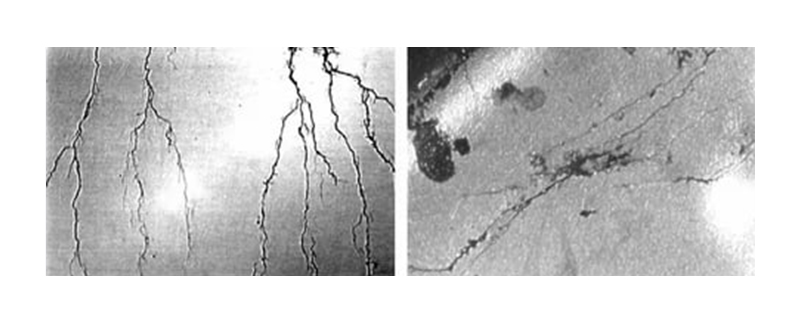
Surface peeling
Local delamination on the surface of the aluminum plate. The delamination is relatively thin and can rupture and peel.
Poor surface flatness of the casting block or incomplete milling of the surface. extended heating time leading to severe surface oxidation.Quick Quote
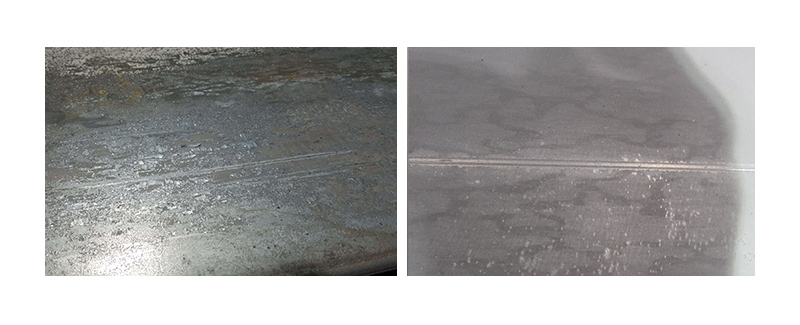
Edge cracking
Edge cracking on the aluminum plate, which can become severe and exhibit a serrated pattern, leading to the overall structural damage of the sheet.
Casting block unevenly heated, sprue not completely removed. in high-magnesium alloys, excessive sodium content in the casting block.
low hot rolling temperature, improper reduction rate control. inadequate edge thickness of hot rolling rolls, improper placement of clad aluminum plates, uneven placement, causing incomplete cladding on one side.
Black spots
Surface impurities from the partial outer layer of the casting block's structure remaining inside the aluminum plate's surface. They appear along the rolling direction, parallel to it, on both sides of the plate with a width of several tens of millimeters, affecting the appearance.
During hot rolling, it is necessary to select a casting block side profile shape that matches the transverse deformation and to mill (plane) the side surface of the casting block.
The edge trimming of the rolled material should be thorough.Quick Quote
Striped patterns in the structure
Streaking or banding parallel to the rolling direction caused by uneven or coarse-grained structure in the casting block. It becomes pronounced after anodizing or acid treatment. Increased acid etching depth may result in width variations or disappearance.
Efforts should be made to rationalize solidification, cooling, and other casting conditions and achieve appropriate grain refinement to prevent uneven grain structure in the casting block.
Performing a rational casting block milling process.
Layering
A longitudinal splitting that occurs in the central section of the cross-section at the end or edge of the aluminum plate, parallel to the rolling direction.
The splitting that occurs at the front and rear ends is referred to as delamination or laminar splitting and is more common in Al-Mg aluminum alloys. The splitting that occurs at the edges of the aluminum plate is known as stratification and is frequently observed in transverse rolling.
Intermixed
On the cross-section of the aluminum plate, strip-shaped cracks parallel to the surface of the sheet material are generated, extending along the rolling direction, distributed irregularly.
The ingot contains non-metallic impurities. the casting contains high gas content and severe porosity.
Press brake
The press break machine pressed over the wrinkled area of the aluminum plate, making that part of the aluminum plate have a bright streak pattern.
It damages the compactness of the aluminum plate, the pressed area is not easy to weld tightly, and affects the overall performance of the material.
The roller shape is incorrect, the aluminum plate is unevenly shaped. the sheet has too much waving before being pressed, or the pressing amount is too large, the speed is too fast.
improper feeding during pressing can easily cause press brakes. a large thickness difference on both sides of the aluminum plate can easily cause press brakes.
Foreign matter indentation
Non-metallic foreign matter is pressed into the surface of the plate, forming obvious dot-like or strip-like black and yellow colors. It damages the continuity of the aluminum plate surface and reduces the corrosion resistance of the aluminum plate.
The rolling equipment conditions are not clean, dirt falls on the plate surface during processing, and is formed during rolling. the injection pressure of the process lubricant is low, and non-metallic dirt adhering to the plate surface is not rinsed off.Quick Quote
the emulsion is not replaced in time, the aluminum powder is not rinsed clean and the emulsion tank is not scrubbed clean. there are scratches on the surface of the billet.
Attention should be paid to keeping the rolling equipment clean.
Metallic inclusion
Metal debris or metal fragments are pressed into the surface of the plate. After the pressed object is scraped off, it leaves irregular depressions. It damages the continuity of the aluminum plate surface and affects the corrosion resistance of the material.
Metal debris falls on the aluminum plate surface during processing and causes indentations after rolling. during hot rolling there is insufficient edging of the rolls, causing metal fragments from split edges to fall on the plate surface.
poor edge quality during circular shear cutting causes burrs to fall on the billet and get pressed in during rolling. compressed air does not completely blow away metal debris on the aluminum plate surface.
after aluminum sticks to the rolls, the stuck aluminum gets pressed onto the billet surface. the gauge holder is clamped too tightly, causing scraped debris to fall on the plate surface.
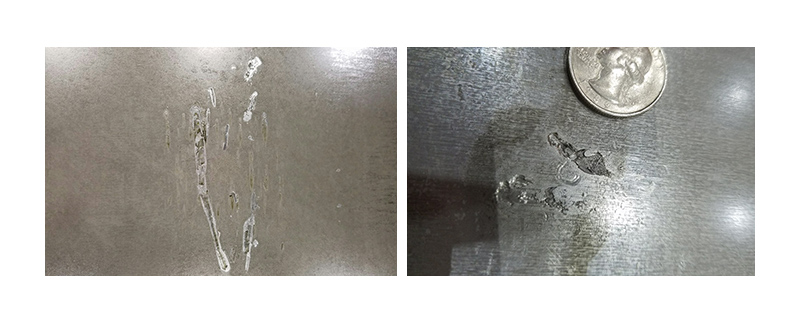
Abrasion mark
Traces left from adjacent aluminum plates rubbing against each other during quenching, the surface shows irregular curved striations, which reduces corrosion resistance.Quick Quote
The curvature of the aluminum plate is too large after quenching, the loading capacity for quenching is too high, the space between aluminum plates is too small. the aluminum plates rub against each other when unloading or hoisting.
Scratch imprint
Scratches and scores produced in the previous process pass through the next rolling process and still show scratch and score marks, but the surface is smoother. These defects are hidden, and reduce the overall performance.
Scratches, adhered scars produced in the rolling process, and abrasions occurring in the annealing and handling processes that get rolled through the subsequent rolling.
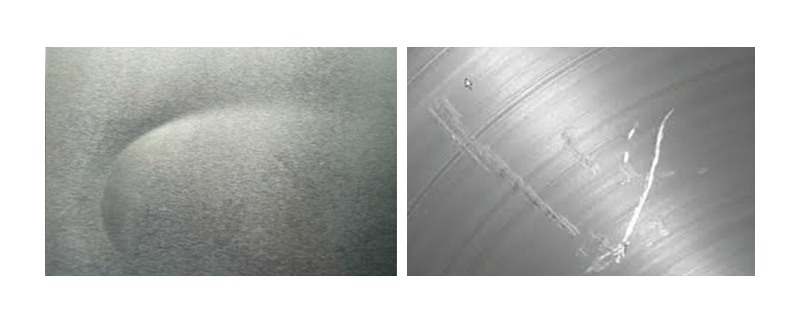
Transport scars
During handling, the aluminum plate surfaces contact each other, and due to vibration rub against each other for a prolonged time, causing black scars.
The aluminum plate surfaces contact each other and due to vibration rub against each other for a prolonged time, causing black scars.
Packaging should be done according to specifications. during transport, prevent loose bundling and prevent sheet movement.
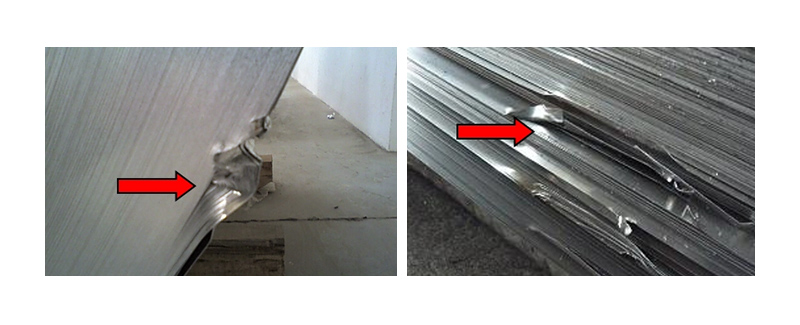
Corrosion
The aluminum plate surface has a chemical or electrochemical reaction with the surrounding medium, causing the metal surface to lose its luster and damage the surface structure. Corrosion appears as patches or spots, white in color, with powder formation in severe cases, which reduces corrosion resistance and overall performance.
In the production process, acid, alkali or water stains remain on the plate surface. auxiliary materials contacting the plates such as fuel oil, emulsions, packaging oil, etc. contain moisture or are alkaline. improper sealing during packaging. the protective layer is damaged during transportation.
Attention should be paid during production, packaging and transportation.
Copper diffusion
During heat treatment, copper atoms in the aluminum alloy substrate diffuse into the cladding layer, forming yellowish-brown spots. This is detrimental to corrosion resistance.
Incorrect heat treatment parameters, excessively high temperature or prolonged time. excessive number of repeated heat treatments, abnormal heat treatment equipment. improper edge rolling during hot rolling, too thin cladding layer.
Correct heat treatment methods are necessary.Quick Quote
Emulsion marks
Residual milky-white or blackish spots, streaks, or patches of emulsion traces on the surface of the sheet. They affect surface roughness and reduce corrosion resistance.
The emulsion was not properly blown off during hot rolling. excessive hot rolling temperatures led to emulsion sintering. high viscosity of the emulsion resulted in it sticking to the plate during rolling.
Nitrate stains
During salt bath quenching, nitrate residues on the aluminum plate surface appear as irregular white patches, significantly reducing corrosion resistance.
Inadequate washing after quenching. insufficient cleaning before polishing. nitrate stains remaining on the surface of the aluminum plate.
Thoroughly clean before quenching and polishing.
Oil stains
Rolling oil residue left on the surface after cold rolling, when sintered at high temperatures, forms brown or red streaks on the aluminum plate surface, affecting its appearance.
Residual lubricating oil on the sheet, when subjected to annealing, results in sintering marks on the surface of the aluminum plate. improper annealing process.
Inspect and clean residual lubricating oil during annealing.
Water stains
Water stains remaining on the quenched plate surface, when pressed, leave light white or light black marks on the surface, affecting aesthetics.
Poor water quality, incomplete drying of water.
Wipe away residual water stains before polishing.
Dull surface
The aluminum plate appears dull and unattractive.Quick Quote
Excessive rolling temperature. insufficient surface roughness of rolling rolls, polishing rolls, and straightening rolls. poor lubricating fluid performance, excessive dirt. different materials of the aluminum plate.
Bright streaks
Irregular bright streaks of varying widths and lengths due to uneven surface roughness on the aluminum plate.
Poor quality of roller grinding. inadequate process lubrication. rolling narrow material before rolling wide material.
Small black spots (streaks)
Irregular black spots (streaks) on the aluminum plate surface.These defects reduce corrosion resistance and affect aesthetics.
Poor emulsion lubrication. unclean emulsion. poor emulsion stability. surface scratches on the aluminum plate. inclusions in the metal.
during rolling of 7-series alloys, a large amount of aluminum powder is generated and pressed into the metal, resulting in small black streaks during further rolling.
Hidden trails
Parallel rolling direction gloss deviation that occurs on the wide plate when switching from a narrow plate. It appears continuously on both sides of the aluminum plate, affecting aesthetics.
Caused by the transfer of adherent substances from the working rolls in contact with the rolled material's edges to the aluminum plate.
Changing the rolling sequence from wide to narrow or replacing the rolls.
Knife marks
Traces left on the surface of the aluminum plate due to the transfer of grinding wheel marks during the grinding process, affecting aesthetics.
Knife marks from the grinding wheel left on the rolls.
Properly control the grinding wheel speed, feed rate, and roll grinding processing conditions. trim the grinding wheel during wheel dressing.
Vibration mark
Straight-line gloss streaks appearing at right angles to the rolling direction with subtle spacing.Quick Quote
Rolling-induced marks are known as rolling marks, while straightening-induced marks are known as straightening marks. They are tangible and common in carbide materials.
To prevent excessive reduction, it's important to arrange the rolling pass sequence properly, control rolling speed appropriately, ensure proper rolling lubrication, and minimize mill vibrations.
Herringbone pattern
Thin-edge gloss defects appearing at a certain angle to the rolling direction.
They are often found in the transverse direction of the sheet and are common in Al-Mg alloys.
Additionally, arranging pass reductions properly, controlling front and rear tension, and ensuring adequate lubrication of process oil can help mitigate these issues.
Impressions (roll marks)
Roller or straightening roller with scars, marks, or discolorations that are transferred to the aluminum plate surface during rolling or straightening. The marks have a periodic distribution.
Rollers and aluminum plate surfaces with metal chips or foreign matter adhering to them, resulting in imprints on the aluminum plate surface as it passes through production machinery. Imprints are easily generated on the aluminum plate surface when other process equipment (such as polishing machines, straightening machines, feed rollers, and guide rollers) have defects or foreign matter adhering to their surfaces.
Imprint defects on the aluminum plate can also occur when the packaging oil roller is pressed too tightly and the oil contains impurities.
Wavy patterns
Waves running across the surface of the aluminum plate in the vertical rolling direction.
During the rolling process, the work rolls vibrate.During the rolling process, there are stoppages or rapid adjustments to the reduction rate.During precision straightening, multi-roll straightening machines stop during significant reductions.Quick Quote
Fiber bundles (burrs)
After shearing or sawing the edges of the aluminum plate, there are small and uneven fine, sharp, and thin metal burrs.
During shearing, the blade is not sharp, the blade lubrication is poor, and the blade clearance and overlap are improperly adjusted.
During sawing, the saw blade or the sheet vibrates.
Shrinkage marks
Dark cracks form at the edges during the hot rolling of the ingot, which are not visible externally but become apparent after sawing.
Poor quality of the ingot melt, often occurring at the pouring mouth area, especially in the case of hard alloys.
Slip line
Dark-colored streaks, running at a 45° angle to the stretching direction, appear on the surface of the stretched aluminum plate. This affects the aesthetics of the sheet and can impact its overall performance when severe.
Excessive stretching.
Change the stretching amount.
Pine branch-like patterns
The slip lines on the aluminum plate's surface, caused by uneven deformation during the rolling process, result in a regular pattern of loose tree branch-like patterns.
When severe, the surface of the sheet becomes uneven with noticeable color variations, but it remains relatively smooth. This primarily affects the visual appearance of the surface and can also impact the overall performance of the product when it becomes severe.
Excessive rolling pressure and poor lubrication during rolling can cause uneven metal flow in different parts of the aluminum plate. This leads to the formation of slip lines on the surface.
Pattern defects
Pattern defects in aluminum checker plate due to incomplete or damaged patterns, insufficient pattern depth, affecting both functionality and aesthetics.
It is mainly caused by damage to the rollers used for rolling aluminum checker plate, where the pattern on the rollers gets filled with aluminum chips or other debris. This can happen if the raw material thickness is insufficient, leading to incomplete filling during rolling.
Mechanical damage to the equipment or poor quality of the pattern plate or ingot itself can also result in pattern damage.
Aluminum plate performance defect analysis
Unsatisfactory mechanical properties
Waste Resulting from Exceeding Standard Mechanical Properties at Room Temperature.
The ingot's chemical composition does not meet technical standards. the heat treatment process was not correctly executed.
There are issues with the heat treatment equipment. the laboratory's heat treatment process or testing methods are incorrect. sample specifications and surface quality do not meet requirements, etc.
Overheating
When the casting block or aluminum plate reaches a temperature during heat treatment that equals or exceeds the eutectic temperature of the low-melting-point constituents, it can cause localized grain coarsening, the formation of liquid phase globules within the grains, and the appearance of triangular shapes at grain boundaries.
This phenomenon disrupts the grain-to-grain bonding, leading to a decrease in overall performance, and such materials are considered absolute scrap or waste.
Uneven temperatures in different zones of the furnace. malfunction of heat treatment equipment or instruments. unreasonable heating or heat treatment procedures, or inadequate execution. improper loading placement.
Casting inclusions
A block-shaped metal or non-metallic substance in the center of the aluminum plate, spanning its entire thickness, disrupting the overall structure of the plate.
This can be described as "During casting, the inclusion of metal or non-metallic substances resulted in this structural defect after rolling.
What to do if you receive defective aluminum plates?
- For critical large orders, request samples from the aluminum plate supplier in advance for testing. Chalco Aluminum provides free samples.Free sample
- Clearly define quality standards and problem-solving solutions in the contract to minimize quality risks.
- You can also inspect the goods at the factory after production. Chalco Aluminum welcomes you to visit the factory at any time.
- If you discover issues upon receipt, first check the quality certificate and contract terms to see if you can hold the aluminum plate supplier responsible. You can also request the supplier to take responsibility for quality issues, providing cost compensation or reductions.
- Inspect the defective areas and assess whether salvage and repair are possible through methods like cutting or patching.
- If the defect area is extensive and cannot be repaired, consider annealing and re-rolling.
- Explore different processing methods to determine if crucial parts can be manufactured while avoiding the defective areas.
- If reuse is not feasible, consider selling the material as scrap at scrap metal prices.
- Keep records of quality issues for future reference when selecting an aluminum plate supplier.
Aluminum plate hot products
Chalco is a professional aluminum plate supplier, and the following are some of Chalco's hot-selling products (custom sizes available):
-
2024 Aluminum Plate
Width: 1250-2500 mm
Length: 2000-4000 mm
Thickness: 0.5-50 mm
-
3003 Aluminum Plate
Width: 20-2650 mm
Length: 2000-4000 mm
Thickness: 0.5-500 mm
-
5052 Aluminum Plate
Width: 1250-2650 mm
Length: 500-16000 mm
Thickness: 0.2-600 mm
-
5083 Aluminum Plate
Width: 100-2600 mm
Length: can be customized
Thickness: 0.5-150 mm
-
5086 Aluminum Plate
Width: 500-2800 mm
Length: 1000-12000mm
Thickness: 0.8-200 mm
-
6061 Aluminum Plate
Width: 100-2800 mm
Length: 500-16000mm
Thickness: 0.3-500 mm
-
6082 Aluminum Plate
Width: 500-2650 mm
Length: 500-12000mm
Thickness: 0.5-300 mm
-
7050 Aluminum Plate
Width: 500-2600 mm
Length: 500-12000mm
Thickness: 0.2-300 mm
-
7075 Aluminum Plate
Width: 100-1500 mm
Length: 500-8000mm
Thickness: 1.0-600 mm
-
High Precision Aluminum Plates
Width: 500-2650 mm
Length: 500-12000mm
Thickness: 4-40 mm
-
Ultra-wide Aluminum Plate
Width: 800-2650 mm
Length: 1000-16500mm
Thickness: 4.5-100 mm
-
Pre-stretched Aluminum Plate
Width: 600-3500 mm
Length: 2000-12000mm
Thickness: 6.3-200 mm
-
Deep-drawn Sheet
Width: 500-2650 mm
Length: 500-12000mm
Thickness: 4-40 mm
-
3003 Aluminium Checker Plate
Width: 1000-1600 mm
Length: 2000-10000mm
Thickness: 1.0-4.5 mm
-
5052 Aluminum Tread Plate
Width: 1000-1600 mm
Length: 2000-10000mm
Thickness: 1.0-4.5 mm


